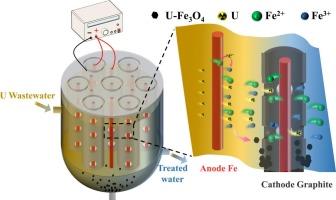新型加速铀矿化电化学反应器:实现铀废水的连续快速处理
IF 9.8
1区 工程技术
Q1 ENGINEERING, CHEMICAL
引用次数: 0
摘要
将废水中的铀酰离子电化学转化为稳定的合成矿物是一种很有前途的减轻再氧化和迁移风险的策略。该技术利用专门的电极,使铀晶格掺杂矿化在环境条件下。然而,由于缺乏能够将实验室规模的摇瓶实验转化为实际工业应用的可扩展设备,铀废水处理连续矿化的实际实施受到了严重阻碍。为了解决这一限制,我们开发了两种不同的电化学矿化反应器配置:线性反应器(LR)和环形反应器(AR),均用于快速批处理模式。这些系统采用铁-石墨电极对,并在不同电极数量、排列和流动状态下系统地评估了铀去除效率、能耗和产品稳定性。与LR反应器相比,采用复合交叉电极设计的AR反应器表现出优异的性能,能耗降低97%,铁用量降低75%。此外,AR反应器的铀去除率超过98.5%,84.5%的铀以矿化形式稳定存在,能耗为56.56 kWh/kg u,参数优化证实了AR反应器适合大规模、节能的铀固定化,促进了可持续矿化技术的实际应用。本文章由计算机程序翻译,如有差异,请以英文原文为准。

Novel electrochemical reactor for accelerated uranium mineralization: Enabling continuous and rapid uranium wastewater treatment
The electrochemical conversion of uranyl ions in wastewater into stable synthetic minerals presents a promising strategy for mitigating reoxidation and migration risks. This technique utilizes specialized electrodes to enable uranium lattice doping mineralization under ambient conditions. Nevertheless, the practical implementation of continuous mineralization for uranium wastewater treatment is significantly hindered by the lack of scalable equipment capable of transitioning laboratory-scale shake-flask experiments into practical industrial applications. To address this limitation, we developed two distinct electrochemical mineralization reactor configurations: a linear reactor (LR) and an annular reactor (AR), both designed for rapid batch-mode treatment. These systems employed iron-graphite electrode pairs and were systematically evaluated for uranium removal efficiency, energy consumption, and product stability under varying electrode quantities, arrangements, and flow regimes. Compared with the LR reactor, the AR reactor, incorporating a composite cross-electrode design, demonstrated superior performance with a 97 % reduction in energy consumption and a 75 % decrease in iron usage. Furthermore, the AR reactor achieved a uranium removal efficiency exceeding 98.5 %, with 84.5 % of the uranium stabilized in a mineralized form, at an energy consumption of 56.56 kWh/kg U. Parameter optimization confirmed the suitability of AR reactor for large-scale, energy-efficient uranium immobilization, promoting the practical application of sustainable mineralization technology.
求助全文
通过发布文献求助,成功后即可免费获取论文全文。
去求助
来源期刊

Desalination
工程技术-工程:化工
CiteScore
14.60
自引率
20.20%
发文量
619
审稿时长
41 days
期刊介绍:
Desalination is a scholarly journal that focuses on the field of desalination materials, processes, and associated technologies. It encompasses a wide range of disciplines and aims to publish exceptional papers in this area.
The journal invites submissions that explicitly revolve around water desalting and its applications to various sources such as seawater, groundwater, and wastewater. It particularly encourages research on diverse desalination methods including thermal, membrane, sorption, and hybrid processes.
By providing a platform for innovative studies, Desalination aims to advance the understanding and development of desalination technologies, promoting sustainable solutions for water scarcity challenges.
 求助内容:
求助内容: 应助结果提醒方式:
应助结果提醒方式:


